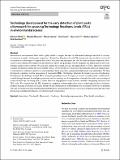Files in this item
Technology development for the early detection of plant pests : a framework for assessing Technology Readiness Levels (TRLs) in environmental science
Item metadata
| dc.contributor.author | White, Rehema | |
| dc.contributor.author | Marzano, Mariella | |
| dc.contributor.author | Fesenko, Elena | |
| dc.contributor.author | Inman, Alan | |
| dc.contributor.author | Jones, Glyn | |
| dc.contributor.author | Agstner, Barbara | |
| dc.contributor.author | Mumford, Rick | |
| dc.date.accessioned | 2022-06-21T12:30:06Z | |
| dc.date.available | 2022-06-21T12:30:06Z | |
| dc.date.issued | 2022-06-20 | |
| dc.identifier | 278684700 | |
| dc.identifier | b729883b-2e24-4403-bc3b-4e49718a5fdc | |
| dc.identifier | 85132146835 | |
| dc.identifier | 000813596900001 | |
| dc.identifier.citation | White , R , Marzano , M , Fesenko , E , Inman , A , Jones , G , Agstner , B & Mumford , R 2022 , ' Technology development for the early detection of plant pests : a framework for assessing Technology Readiness Levels (TRLs) in environmental science ' , Journal of Plant Diseases and Protection , vol. First Online . https://doi.org/10.1007/s41348-022-00599-3 | en |
| dc.identifier.issn | 1861-3829 | |
| dc.identifier.other | ORCID: /0000-0002-9669-0012/work/114977426 | |
| dc.identifier.uri | https://hdl.handle.net/10023/25554 | |
| dc.description | This work was supported by a grant funded jointly by the Biotechnology and Biological Sciences Research Council, the Department for Environment, Food and Rural Affairs, the Economic and Social Research Council, the Forestry Commission, the Natural Environment Research Council and the Scottish Government, under the Tree Health and Plant Biosecurity Initiative. | en |
| dc.description.abstract | Innovation in environmental fields such as plant health is complex because of unbounded challenges and lack of certainty of commercial uptake. In this paper we present a Technology Readiness Level (TRL) framework, specifically to assist with assessment of technologies to support detection of tree pests and pathogens, but also for wider potential adaptation. Biosecurity can be enhanced by improved early detection of pests and pathogens, but development and deployment of new technologies requires robust scrutiny. We critically analyse the concept, practice and applicability of TRLs. Interviews revealed scientist perspectives during the development process of five novel early plant pest and pathogen detection technologies. A retrospective, collective narrative of one technology from concept to commercial deployment was undertaken. We then developed a calculator tool for assessment of biosecurity TRLs. Our findings illustrate the iterative process of technology development, the challenges in final TRLs of acquiring funding to move from proven success to viable product, inefficiencies created through the need for multiple projects for each technology and the imperative to consider the wider socio-ecological technical landscape, including policy context. End user engagement was particularly valuable at beginning and end of the TRL scale. We conclude that the TRL framework comprises a robust approach to assess technologies in that it facilitates progress tracking, evaluation of success likelihood and identification of opportunities for investment. However, its potential will only be realised for environmental management if it is integrated into the socio-ecological technical landscape and wider discussions regarding knowledge co-production and valuing nature. | |
| dc.format.extent | 13 | |
| dc.format.extent | 1383781 | |
| dc.language.iso | eng | |
| dc.relation.ispartof | Journal of Plant Diseases and Protection | en |
| dc.subject | Innovation | en |
| dc.subject | Tree health | en |
| dc.subject | Biosecurity | en |
| dc.subject | Co-design | en |
| dc.subject | Knowledge implementation | en |
| dc.subject | Plant heath surveillance | en |
| dc.subject | SB Plant culture | en |
| dc.subject | 3rd-DAS | en |
| dc.subject.lcc | SB | en |
| dc.title | Technology development for the early detection of plant pests : a framework for assessing Technology Readiness Levels (TRLs) in environmental science | en |
| dc.type | Journal article | en |
| dc.contributor.institution | University of St Andrews. Geographies of Sustainability, Society, Inequalities and Possibilities | en |
| dc.contributor.institution | University of St Andrews. School of Geography & Sustainable Development | en |
| dc.contributor.institution | University of St Andrews. Scottish Oceans Institute | en |
| dc.contributor.institution | University of St Andrews. St Andrews Sustainability Institute | en |
| dc.identifier.doi | 10.1007/s41348-022-00599-3 | |
| dc.description.status | Peer reviewed | en |
This item appears in the following Collection(s)
Items in the St Andrews Research Repository are protected by copyright, with all rights reserved, unless otherwise indicated.

